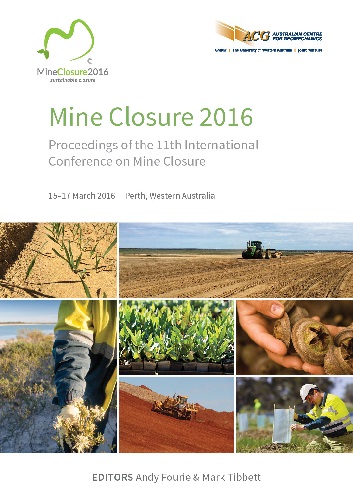The eye of the beholder — utility and beauty in mine closure

|
Authors: Harvey, BE |
DOI https://doi.org/10.36487/ACG_rep/1608_0.3_Harvey
Cite As:
Harvey, BE 2016, 'The eye of the beholder — utility and beauty in mine closure', in AB Fourie & M Tibbett (eds), Mine Closure 2016: Proceedings of the 11th International Conference on Mine Closure, Australian Centre for Geomechanics, Perth, pp. 17-23, https://doi.org/10.36487/ACG_rep/1608_0.3_Harvey
Abstract:
Maximising sustainable mine closure outcomes requires a business-connected approach that takes full advantage of ongoing human and economic occupation of former mine sites. This is evidenced in the majority of successful mine closures around the world, particularly in well-populated regions. Flying in the face of this experience, current mine closure regulation, planning and implementation frequently focuses on the minutiae of environmental remediation. These two perspectives are laced with inherent tensions and contradictions that, left unresolved, will lead to suboptimal mine closure plans that will be difficult to reset when new ideas and economic options emerge. Companies, communities and regulators faced with mine closure scenarios should explicitly place future economic occupation of mine sites at the forefront of mine closure visioning and leave open future options for creative human enterprise.
References:
Breadmore, RE & Lafferty, GJ 2015, ‘Mine closure and first nations – social licence strategies for effective community engagement’, in AB Fourie, M Tibbett, L Sawatsky & D van Zyl (eds), Proceedings of the 10th International Conference on Mine Closure, InfoMine, pp. 753–762.
Costa, S 2015, ‘Social impacts of mine closure: engaging employees and host communities in planning for closure’, in AB Fourie, M Tibbett, L Sawatsky & D van Zyl (eds), Proceedings of the 10th International Conference on Mine Closure, InfoMine, pp. 797–804.
Harvey, BE 2013, ‘Social Development will not deliver social licence to operate for the extractive sector’, Extractive Industries and Society, vol. 1, no. 1, pp. 7–11.
ICMM (International Council on Mining and Metals) 2011, Planning for Integrated Mine Closure Toolkit, London.
Jones, CE & MacLean, MLA 2013, ‘Reclaimed landscapes – incorporating cultural values’, in M Tibbett, AB Fourie & C Digby (eds), Proceedings of the Eighth International Conference on Mine Closure, Australian Centre for Geomechanics, Perth, pp. 441–446.
Pearman, GI 2009, 101 things to do with a hole in the ground, Eden Project, United Kingdom.
Smith, HD & Thompson, A 2013, ‘Towards closure at Jabiluka: rehabilitation of the Boyweg-Almudj sacred site complex’, in M Tibbett, AB Fourie & C Digby (eds), Proceedings of the Eighth International Conference on Mine Closure, Australian Centre for Geomechanics, Perth, pp. 423–429.
© Copyright 2025, Australian Centre for Geomechanics (ACG), The University of Western Australia. All rights reserved.
View copyright/legal information
Please direct any queries or error reports to repository-acg@uwa.edu.au
View copyright/legal information
Please direct any queries or error reports to repository-acg@uwa.edu.au